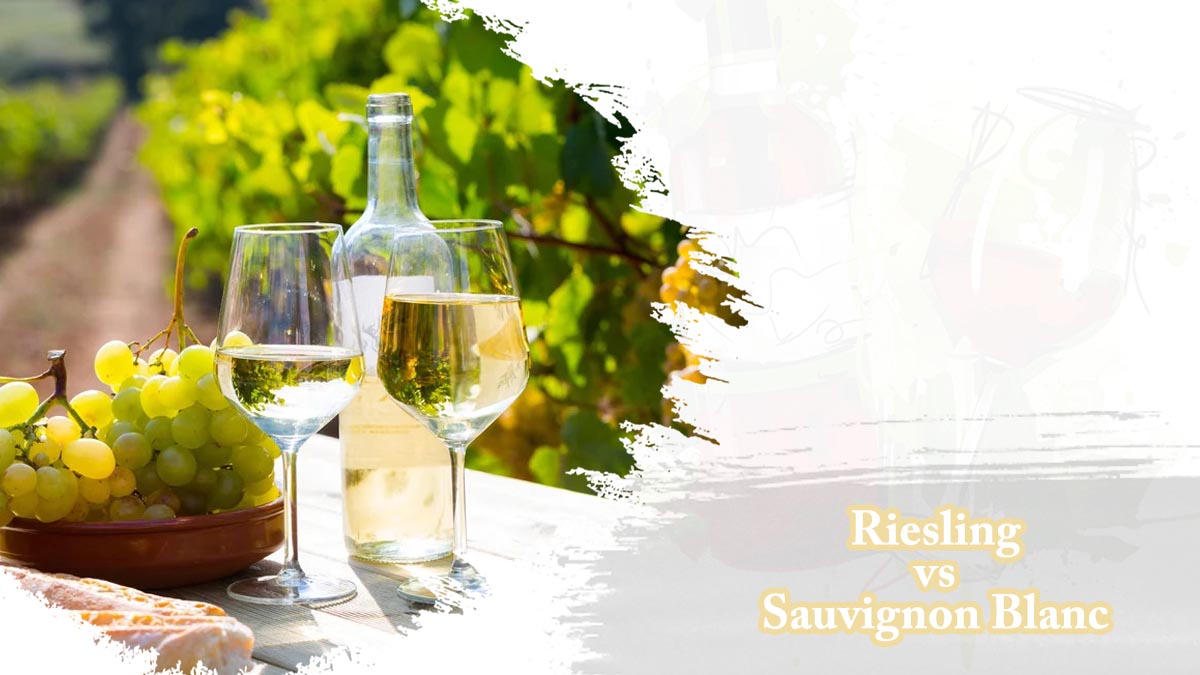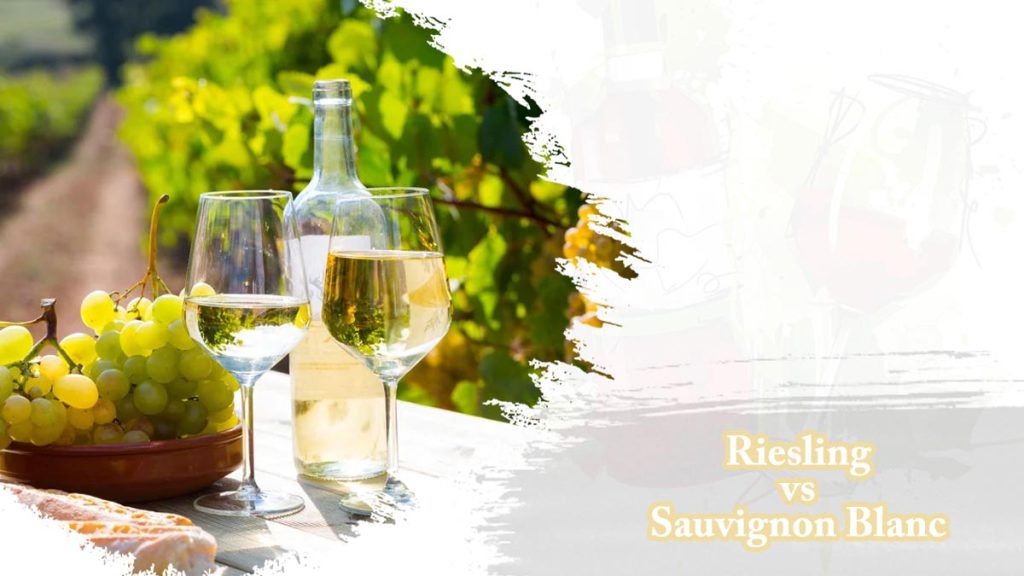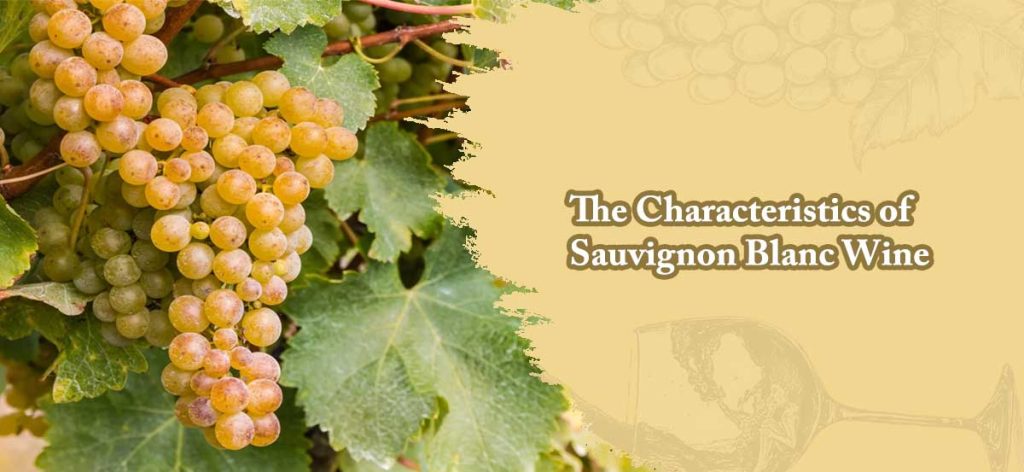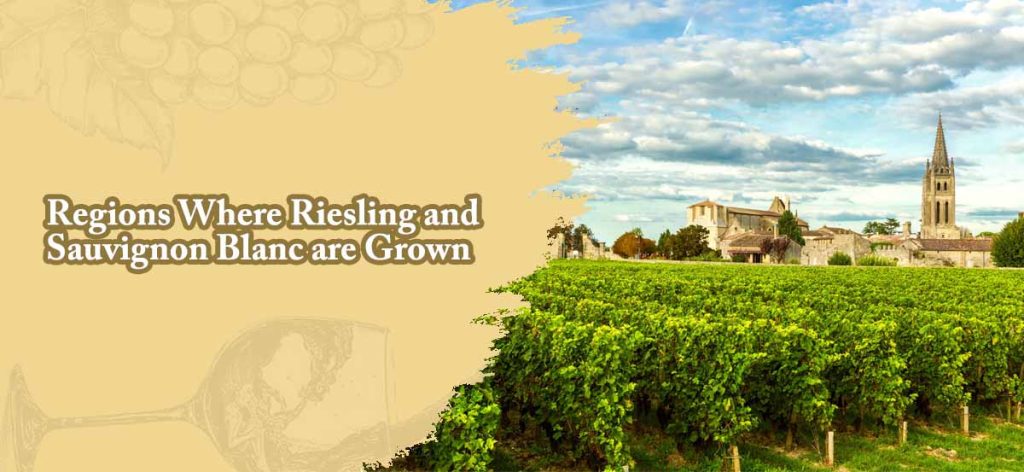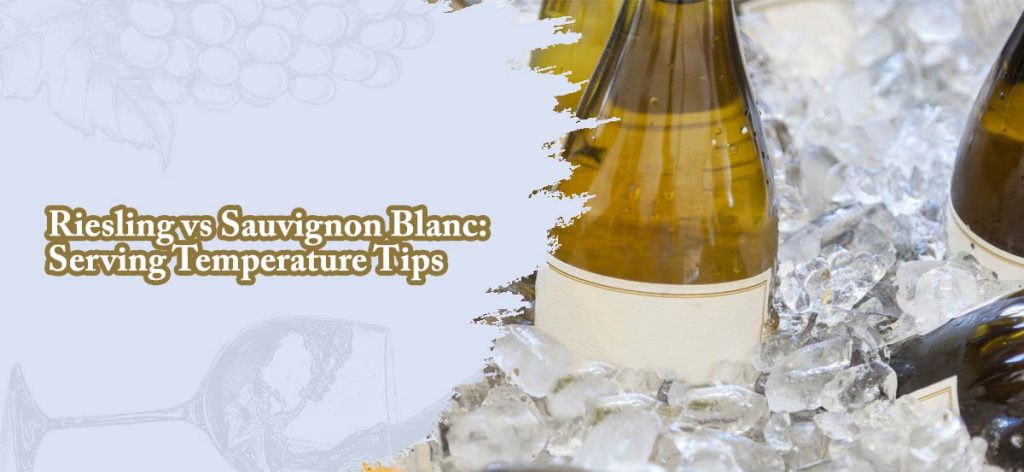Riesling vs Sauvignon Blanc
When it comes to choosing a white wine, the debate between Riesling vs Sauvignon Blanc is always one of the most hotly contested. With so much variation in flavor, aroma, and body between these two popular varietals, it can be hard to decide which should make its way into your home bar or dinner party. But have no fear – we’re here to provide you with all the necessary information to make an educated decision.
Riesling is a white wine grape variety that originated in Germany. It produces light to medium-bodied wines with vibrant acidity, fresh aromas, and distinctive flavors like peach and honey. Rieslings are usually dry but can also be made sweet or sparkling.
Sauvignon Blanc is a white wine grape variety that was first planted in France’s Bordeaux region. It is known for producing crisp, refreshing wines with herbal notes, bright acidity, and intense citrus fruit flavors. Sauvignon Blancs can range from bone dry to quite sweet depending on where they are grown and how they were fermented.
Above is just a brief look at these two types of wine. In this post, we’ll look at the flavor characteristics of each wine as well as food pairings that make them truly stand out! So pour a glass and settle in – let’s sort through Riesling vs Sauvignon Blanc once and for all! By the end of this Riesling vs Sauvignon Blanc comparison, you’ll have a better understanding of which type of wine is best suited to your taste and the occasion. So grab a glass and let’s get started!
Characteristics Differences Between Riesling and Sauvignon Blanc
The Characteristics of Riesling Wine
As one of the most popular white wines in the world, Riesling is known for its unique characteristics and subtle sweetness. This wine has a wide range of flavors, aromas, and textures that make it an ideal choice for any occasion.
I. Appearance: Riesling is usually a pale yellow color. However, it can range from light yellow to golden in hue depending on the age of the wine. Some variations also have an orange or pinkish tinge due to oxidation or aging in oak barrels.
II. Aroma: The aroma of Riesling is often described as having floral notes, such as rose petals or lilacs, which are accompanied by aromas of ripe fruits like apples and pears. Other common aromas include honey, spice, herbs, and minerals like slate or chalkiness.
III. Sweetness: The sweetness level of Riesling depends on where it was made and how long it was aged. Wines made with grapes grown in warmer climates will be sweeter than those grown in cooler climates and many winemakers add residual sugar when making their wines to create a semi-sweet taste.
IV. Body: The body of Riesling is typically light-bodied but some variations have fuller bodies due to longer aging times or warmer temperatures during fermentation processes that give them more structure and weight on the palate.
V. Tannin Levels: Generally speaking, most Rieslings don’t contain any tannins since they’re not aged in oak barrels; however, some variations have higher levels due to longer fermentations or contact with oak barrels during aging processes.
VI Acidity Levels: One of the defining characteristics of Rieslings is their high acidity levels which give them their crispness and refreshing qualities; however, this can vary depending on where the grapes were grown and how long they were aged before bottling.
VII Alcohol Content: Most Rieslings have an alcohol content between 10% – 12%, though some variants may reach up to 14%.
All in all, there’s no denying that Riesling is one of the most popular white wines out there due to its unique flavor profile and versatility when it comes to pairing with food dishes!
The Characteristics of Sauvignon Blanc Wine
Sauvignon Blanc is a white wine grape variety grown in cooler climate regions around the world. The grape produces wines with a wide range of flavors, depending on where it is grown, making it one of the most versatile grapes for winemaking. Here are the key characteristics of Sauvignon Blanc.
I. Appearance: The color of Sauvignon Blanc can range from pale straw to greenish hues. The wines made from this grape variety are usually quite clear and bright.
II. Aroma: One of the most distinctive characteristics of Sauvignon Blanc is its aroma. The grape variety is known for its intense, pungent aromas, which can include grassy, herbal, tropical fruit, and gooseberry notes.
III. Sweetness: Sauvignon Blanc wines are typically dry, with little to no residual sugar remaining after fermentation. However, some producers will make late-harvest or dessert wines using Sauvignon Blanc grapes that have high levels of sugar.
IV. Body: The body of Sauvignon Blanc wines can range from light to medium-bodied. The wines tend to have high acidity, which gives them a refreshing mouthfeel and crisp finish.
V. Tannin Levels: Sauvignon Blanc wines have very low tannin levels, which contributes to their overall refreshment factor.
VI. Acidity: As mentioned before, Sauvignon Blanc wines have high acidity levels, which give them a zippy character and vibrant flavor profile.
VII. Alcohol Content: The alcohol content of Sauvignon Blanc wines can range from 12% to 14%, although some producers will make lower-alcohol versions or use cool climate grapes to produce lighter-bodied styles with lower alcohol levels.
Sauvignon Blanc is a refreshing white wine grape variety that is perfect for summer sipping. The grape produces wines with intense aromatics and high acidity levels that make them perfect for pairing with food or enjoying on their own.
Food Pairings for Riesling and Sauvignon Blanc
The Best Foods to Pair with Riesling Wine
Riesling wine is a versatile white wine that pairs well with a variety of foods. Whether you’re looking for a light and refreshing wine to enjoy with a summer meal or a richer, sweeter wine to enjoy with dessert, Riesling is a great option.
Riesling + Seafood
Riesling is a great wine to enjoy with seafood thanks to its light and refreshing flavor. We recommend pairing Riesling with lobster, crab, or shrimp. The acidity in Riesling will cut through the richness of the seafood and the sweetness will balance out the saltiness.
Riesling + Spicy Foods
If you’re a fan of spicy food, then you’ll love pairing Riesling with dishes like Thai curry or Szechuan noodles. The sweetness of the wine will help to offset the spice of the dish and the acidity will refresh your palate in between bites. Trust us, this is a pairing that you have to try!
Riesling + Cheese
Riesling is also a great wine to pair with cheese. The sweetness of the wine will complement the creaminess of the cheese while the acidity will help to cleanse your palate. We recommend pairing Riesling with softer cheeses like Brie or Camembert.
We hope you enjoyed learning about some of our favorite food pairings for Riesling wine. Remember, when it comes to pairing food and wine, there are no hard and fast rules.
The Best Foods to Pair with Sauvignon Blanc
When selecting food to pair with Sauvignon Blanc, look for dishes that are light in flavor and texture. Here are some delicious food pairings that will enhance the flavor of your favorite white wine.
Fish Dishes
The clean and crisp taste of Sauvignon Blanc pairs perfectly with fresh fish and seafood. White-fleshed fish such as tilapia, sea bass, and cod are perfect choices. The light flavor won’t overpower the delicate taste of sauvignon blanc, but will still provide enough contrast to bring out the best in both flavors. Grilled salmon is also an excellent choice; its natural oils add depth to the bright acidity of the wine.
Cheese Platters
Sauvignon blanc is often served as an accompaniment to cheese platters featuring milder cheeses like brie or camembert. Its citrusy notes bring out the creamy texture and buttery flavors of these soft cheeses. For sharper cheeses like cheddar or Swiss, opt for a slightly sweeter version of sauvignon blanc so that it doesn’t get lost among the sharpness of these bolder cheeses.
Vegetable Dishes
The high acidity content in sauvignon blanc makes it an ideal pairing for vegetable-based dishes such as salads or roasted vegetables. The bright flavors in this type of wine help balance out any bitterness from greens like kale or spinach while picking up on sweet notes in root vegetables like carrots and beets. Sauvignon Blanc can also highlight savory components like garlic or herbs used in vegetable-based dishes.
Sauvignon Blanc is a great choice when you’re looking for a refreshing beverage to accompany your meal; its light flavor profile makes it versatile enough to pair with a range of dishes from lighter fish options to salads and roasted vegetables.
Regions Where Riesling and Sauvignon Blanc are Grown
Both Riesling and Sauvignon Blanc are two of the most popular white wines in the world. They are both produced from different grape varietals, have distinct flavor profiles, and are grown in a variety of global regions. So now, we will explore some of the regions where these two grapes are grown.
Riesling: Riesling is a German grape varietal with an incredibly diverse range when it comes to the style and taste of its wines. It is grown mainly in Germany, Austria, Alsace (France), Australia, New Zealand, and various parts of North America. Depending on where it is grown, Riesling can produce wines that range from bone dry to sweet dessert wines. The German version tends to be more aromatic with high acidity levels while those from Alsace tend to be drier and more mineral-driven.
Sauvignon Blanc: Sauvignon Blanc originated in France but has since spread around the world. This grape produces light-bodied white wines that tend to be crisp and acidic with citrusy notes like lime or lemon. It is grown mainly in France (Bordeaux and Loire Valley), New Zealand (Marlborough), Chile, California, Washington State, South Africa, Italy (Tuscany), Australia (Adelaide Hills), and Canada (Okanagan Valley) among other places. Each region produces its unique style which can vary greatly in terms of taste profile and aroma characteristics.
As you can see, Riesling and Sauvignon Blanc are two of the most widely planted white grapes in the world. While they share some similarities – such as their crisp acidity – they also possess distinct flavors based on where they are grown.
Popular Brands of Riesling and Sauvignon Blanc
Riesling and Sauvignon Blanc are two of the most popular white wines in the world. Both wines have different flavors, aromas, and textures, making them ideal for pairing with a variety of foods. Many different brands make these popular varietals but some stand out from the rest. Let’s take a look at some of the best brands for both Riesling and Sauvignon Blanc.
Riesling: Riesling is one of the oldest grape varieties in the world and has been grown in Germany for centuries. Today, there is a wide range of styles and quality levels available on store shelves. Some of the top brands to look for include Eroica from Washington State, Dr. Loosen from Germany, Chateau Ste Michelle from Oregon, Joseph Drouhin from France, and Schmitt Söhne from Austria. All five producers offer high-quality wines that should please any Riesling lover.
Sauvignon Blanc: Sauvignon Blanc is an aromatic white wine that originated in France but is now produced all over the world. Some of the top producers to keep an eye out for include Kim Crawford Wines from New Zealand, Duckhorn Vineyards from California, Cloudy Bay Winery from Marlborough (New Zealand), Chalk Hill Estate Wines from Sonoma County (California), and Vasse Felix Wines from Western Australia. These brands all offer great examples of Sauvignon Blanc with distinctive aromas and flavors.
Whether you’re looking for a dry or sweet Riesling or a crisp Sauvignon Blanc, there are plenty of great options to choose from. The five brands mentioned here all offer high-quality wines that can easily be found in stores around the world.
How to Store Riesling vs Sauvignon Blanc
The Right Way to Store Riesling and Sauvignon Blanc Wines
If you’re a fan of white wines, chances are that you’ve tried or heard of two popular types of white wine: riesling and sauvignon blanc. They are two distinct wines with very different flavor profiles. Understanding how to store them properly can ensure that they reach their peak flavor profile when you serve them. Let’s look into why storage matters for these two wines and what the optimal storage conditions are for each type.
Why Storage Matters for White Wines
White wines are not known for their aging potential like some red wines may have; instead, they should be enjoyed relatively soon after purchase. That means that if you buy a bottle or two of your favorite riesling or sauvignon blanc, it is important to store them correctly so they taste as good as possible when you open them up. Improper storage can cause oxidation, which leads to off-flavors and an overall unpleasant drinking experience.
The Difference Between Storing Riesling vs Sauvignon Blanc
Rieslings tend to feature sweeter notes than Sauvignon Blancs, which often have more herbal flavors or grassy notes than their sweeter counterparts. As such, they require different storage conditions to reach their peak flavor profile when sipped on. Riesling should be stored in cool temperatures between 45-50 degrees Fahrenheit, while sauvignon blanc should be stored at slightly warmer temperatures between 50-55 degrees Fahrenheit for maximum enjoyment. Both types also benefit from being stored away from direct sunlight and in an area with low humidity levels to prevent spoilage due to the natural environment.
When it comes time to store your favorite Riesling and Sauvignon Blanc bottles, there is no “one size fits all” approach—each type requires specific temperature ranges to reach its full flavor potential when served up at dinner parties or casual get-togethers with friends! By keeping your whites stored in cool temperatures within the right range (45-50 degrees Fahrenheit for riesling; 50-55 degrees Fahrenheit for sauvignon blanc) and away from light and humidity, you can ensure that every sip will taste as delicious as possible!
Riesling vs Sauvignon Blanc: Serving Temperature Tips
Riesling and Sauvignon Blanc are two of the most popular white wines. But what are the best serving temperatures for each?
Riesling is a versatile wine that can be enjoyed young and fresh or aged and complex. Meanwhile, Sauvignon Blanc is a zesty wine with high acidity. Here are some tips on serving temperature for Riesling vs Sauvignon Blanc.
Riesling Serving Temperature Tips
Riesling is a versatile wine that can be enjoyed young and fresh or aged and complex. The ideal serving temperature for Riesling depends on the style of wine.
For young and fresh Rieslings, a colder temperature will help to preserve the wine’s fruitiness. Serve these wines at around 50-60°F (10-15°C).
For more complex and aged Rieslings, a warmer temperature will help to bring out the wine’s aromas and flavors. Serve these wines at around 60-70°F (15-21°C).
Sauvignon Blanc Serving Temperature Tips
Sauvignon Blanc is a zesty wine with high acidity. The ideal serving temperature for Sauvignon Blanc is between 50-60°F (10-15°C). This will help to preserve the wine’s refreshing acidity.
When it comes to white wine, Riesling and Sauvignon Blanc are two of the most popular choices. But what is the best serving temperature for each?
Riesling is a versatile wine that can be enjoyed young and fresh or aged and complex. The ideal serving temperature for Riesling depends on the style of wine. For young and fresh Rieslings, a colder temperature will help to preserve the wine’s fruitiness.
Serve these wines at around 50-60°F (10-15°C). For more complex and aged Rieslings, a warmer temperature will help to bring out the wine’s aromas and flavors. Serve these wines at around 60-70°F (15-21°C).
Sauvignon Blanc is a zesty wine with high acidity. The ideal serving temperature for Sauvignon Blanc is between 50-60°F (10-15°C). This will help to preserve the wine’s refreshing acidity.
Three Recipes that Feature Riesling or Sauvignon Blanc as an Ingredient
Riesling and Sauvignon Blanc are two of the most popular varieties of white wine. They are also two of the most versatile when it comes to cooking. Riesling is known for its sweetness, while Sauvignon Blanc is known for its acidity. Both wines can be used to create delicious, mouth-watering dishes. We will share three recipes that feature Riesling or Sauvignon Blanc as an ingredient.
Riesling Braised Chicken Thighs – This dish features succulent chicken thighs that have been braised in a sweet and savory Riesling sauce. The sauce is made with shallots, garlic, thyme, and of course, Riesling. This dish is perfect for a winter night when you want something warm and comforting. Serve it with a side of mashed potatoes or roasted vegetables.
Sauvignon Blanc Steamed Mussels – This recipe features fresh mussels that have been steamed in a fragrant Sauvignon Blanc broth. The broth is made with garlic, shallots, fennel, and fresh herbs. This dish is perfect for summertime when you want something light and refreshing. Serve it with a baguette for dipping into the delicious broth.
Riesling Poached Pears – This recipe features pears that have been poached in spiced Riesling syrup. The syrup is made with cinnamon, star anise, cloves, and of course, Riesling. This dish is perfect for dessert or a light snack. Serve it with a dollop of whipped cream or ice cream for an extra special treat.
We hope you enjoyed these three recipes that feature Riesling or Sauvignon Blanc as an ingredient.
FAQs
Is Riesling Sweeter Than Sauvignon Blanc?
The answer to this question is that it depends. Riesling can range from dry to sweet, while Sauvignon Blanc typically has a crisp and tart flavor with low residual sugars. Dry Rieslings tend to be lighter-bodied than their sweeter counterparts, whereas Sauvignon Blanc tends to have a higher acidity level no matter its sweetness level. Ultimately, the sweetness of both wines will depend on the winemaker’s style and preferences as well as the growing conditions during harvest.
If you’re looking for a particularly sweet white wine, then Riesling might be your best bet—but don’t forget about other varietals like Gewurztraminer or Moscato that may be even sweeter. Ultimately, it’s best to experiment with different styles of wines and find the one that suits your palate best!
Is Sauvignon Blanc Considered Sweet or Dry?
Sauvignon Blanc can be either sweet or dry, depending on the winemaking techniques used and how much residual sugar remains in the finished product. Most Sauvignon Blanc wines are dry, with crisp acidity and herbal, citrusy aromas and flavors. Some producers will also make sweeter styles of Sauvignon Blanc by allowing some of the grape’s natural sugars to remain unfermented, resulting in a slightly fruity wine. In general, however, most versions of this white wine are bone-dry and refreshing.
As with all wines, it is important to read the label carefully before purchase to determine whether a particular bottle is sweet or dry!
Is Riesling Wine Dry or Sweet?
Riesling wine can range from dry to sweet on the sweetness scale. The dryness of Riesling depends largely on where it is grown, as well as how ripe the grapes were when harvested. In general, wines that come from cooler climates like Germany are typically drier than those from warmer regions like Australia or New Zealand. Grapes picked earlier in the harvest season tend to be less sweet than those picked later.
There are also special techniques and processes winemakers use to enhance or reduce a Riesling’s sweetness levels, so there is quite a bit of variety in terms of taste. Ultimately, you’ll need to look at the label of a particular bottle to determine its exact sweetness level. Depending on your preference, you should be able to find a Riesling that suits your palate.
Is Sauvignon Blanc Better Warm or Cold?
This question is highly subjective and depends on the individual’s preference. Generally, Sauvignon Blanc should be served chilled between 45-55°F (7-12°C) to bring out its fruity, grassy aromas. However, some prefer a milder flavor at slightly warmer temperatures of 55-60°F (13-15°C). Ultimately, it’s up to personal taste and experimentation to determine what temperature works best for each individual.
When in doubt, it’s best to start with a lower temperature and gradually increase until you find the ideal serving temperature. Additionally, if you are pairing Sauvignon Blanc with food, serve it slightly below room temperature—around 50°F (10°C)—to allow the flavors of both the food and wine to shine.
Keep in mind that if Sauvignon Blanc is served too cold, you may miss out on its full flavor profile. But if it’s served too warm, it can become unpleasantly acidic. The key to finding your perfect serving temperature is to experiment until you find what works best for you and your palate.
Why is Sauvignon Blanc So Popular?
Sauvignon Blanc is one of the most popular white wines due to its crisp and refreshing taste. Its acidity gives it a bright, tart flavor that pairs well with many types of food. Sauvignon Blanc is also known for its mineral quality, which gives it a distinctively earthy taste. Because of this, Sauvignon Blanc can be enjoyed with a variety of dishes including seafood, salads, grilled meats and poultry, creamy cheeses, and even some desserts.
In addition to its flavorful profile, Sauvignon Blanc is relatively budget-friendly when compared to other premium whites on the market. This affordability makes it an attractive choice for casual sipping or pairing with meals. As an added bonus, Sauvignon Blanc has lower alcohol content than many other wines which makes it an ideal choice for enjoying over a longer period.
Sauvignon Blanc is also a great wine to explore if you’re new to the world of wines. Its bright and vibrant qualities are fun to experience and can help expand your palate. Additionally, as you become more experienced in tasting different varieties of wine, Sauvignon Blanc gives you just enough complexity to be interesting but still makes for easy drinking.
For these reasons and more, it’s easy to understand why Sauvignon Blanc is one of the most popular white wines on the market today!
What is the Best Way to Drink Riesling?
The best way to enjoy a glass of Riesling is to serve it slightly chilled (around 45-50 degrees Fahrenheit) and in a smaller wine glass that allows for the bouquet of aromas to be fully enjoyed. For truly optimal enjoyment, serve Riesling with food that highlights its acidity, such as oysters or spicy dishes.
Additionally, try pairing dry Rieslings with seafood, shellfish, pasta carbonara, or roasted vegetables and sweet Rieslings with milder cheeses like Brie or Camembert. By experimenting with different pairings, you can discover the perfect flavor combination for your palate. Lastly, don’t forget to take your time and savor every sip! Enjoying an exquisite bottle of Riesling is an experience to be taken slowly, so take a moment to appreciate its unique qualities.
What are the 3 Types of Riesling?
The three main types of Riesling are: dry, semi-dry, and sweet. Dry Rieslings have a higher acidity level, but also feature mineral and citrus flavors such as lemon, lime, or grapefruit. Semi-dry Rieslings still have some sweetness to them, but not as much as sweet Rieslings. Sweet Rieslings often contain aromas of peach, apricots, and honey that are complemented by floral notes like roses or jasmine.
All three types are easy to pair with food due to their complexity and range of flavors. Some popular dishes for pairing with each type include fish tacos with lime wedges for dry Riesling, roasted pork tenderloin with apple compote for semi-dry, and crème brulee for sweet Riesling. With the different types of Rieslings available, there is something for everyone to enjoy!
Additionally, other distinctions in types of Riesling can be made based on how they were made. For example, Kabinett wines are late-harvested and lightly sweetened while Spätlese wines are made with slightly riper grapes that have a fuller body and sweeter taste. Auslese wines are even riper than Spätlese and have an even sweeter flavor profile. Finally, Beerenauslese wines are made with individually selected overripe or dried berries to give them a unique flavor. All four of these styles offer different tastes and pairings, making them a great option to explore.
No matter which type of Riesling you choose, it’s sure to be a refreshing and delicious experience! Whether it is dry, semi-dry, or sweet, there is something for everyone to enjoy. So don’t miss out on the opportunity to explore the amazing world of Riesling!
Conclusion
As we have seen, both Riesling and Sauvignon Blanc have unique qualities. Their flavor profiles can provide awesome accompaniments to a variety of meals or can stand out as the star of the meal. Depending on what type of flavor preference you lean towards, either one of these varieties could be great to choose.
However, it’s important to keep in mind the residual sugar content in each when choosing if that factor is important to you. It has been said that they both could go well with just about anything, but what today’s wine consumers are ultimately deciding is which of these two contenders reign supreme!
Thanks for taking part in this exploration with me as we sought out answers as to whether Riesling or Sauvignon Blanc is king. Come back again soon and perhaps together we can investigate yet another varietal together!
Visit our Website for more interesting things.

I am Thomas Delange, CEO of McMahon’s Public House bar. I have a passion for restaurants and cooking & wines, and I love to spend my free time experimenting in the kitchen. I’ve worked hard to make McMahon’s one of the most successful bars in the city. When I’m not working, I enjoy spending time with my friends and family.

